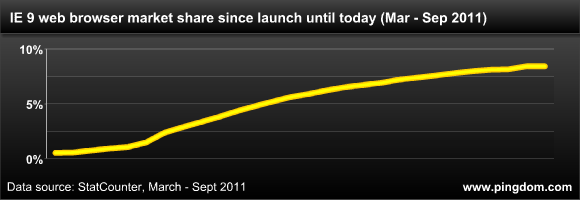![]() We are in the middle of a new browser war, with Microsoft, Mozilla and Google all fighting for Web and HTML 5 supremacy. Ok, that was a bit dramatic, but there is some seriously intense competition going on right now.
We are in the middle of a new browser war, with Microsoft, Mozilla and Google all fighting for Web and HTML 5 supremacy. Ok, that was a bit dramatic, but there is some seriously intense competition going on right now.
With that in mind, you’d expect all three companies to do their utmost to get their latest and greatest web browsers on as many computers as possible. Google is doing that with Chrome. Mozilla is doing that with Firefox.
Microsoft is NOT doing that with Internet Explorer. Big emphasis on “not.”
The Windows XP dilemma
Let’s first ignore that Microsoft isn’t developing IE for operating systems other than its own. After all, that’s understandable. Windows is Microsoft’s main baby and has roughly 90% of the worldwide desktop OS market anyway. Microsoft can afford to cut the other 10% loose.
The problem is that Microsoft’s latest web browser, IE 9, won’t work on Windows XP. It needs Windows Vista or later. Not only that, IE 10 will take this one step farther, requiring Windows 7 or later.
We should add that the latest versions of both Chrome and Firefox work just fine on Windows XP. There’s irony for you.
Windows XP may be older than the Ford Model T, but it’s still the most widely used version of Windows today. Almost half of all Windows machines worldwide run XP. It will have a huge chunk of the market share for quite some time, so why handicap IE in this way?
The theoretical upper limit for IE 9
As of August 2011, this is how the Windows versions are divided (based on worldwide Web usage, source: StatCounter):
- Windows XP – 46.6%
- Windows 7 – 41.2%
- Windows Vista – 12.2%
So with the current division, the most IE 9 could currently hope for is just over half of the IE installations, assuming an even division of IE usage across Windows versions. That’s in the highly unlikely scenario that it manages to be installed on 100% of the Windows 7 and Windows Vista machines out there.
IE 9 adoption is hardly going that well, though. It currently represents 19% of all IE usage (two fifths of its potential, remember, it can currently not go above roughly 50%), which translates to an 8% share of the overall browser market. (All versions of IE counted together have a 41.9% web browser market share.)
Microsoft’s strategy is stalling IE 9 adoption
It doesn’t take a genius to figure out that cutting away roughly half of your potential market will hamper user adoption. Also, with a smaller potential market, adoption will slow down faster.
And it’s already slowing down. Judging by the trend, it even looks like IE9 adoption is about to plateau. Case in point, Microsoft reportedly ran a push through Windows Update late in June that was supposed to get IE 9 adoption numbers up. It doesn’t seem to have had much effect at all.

We wrote about the painfully slow user adoption for IE 9 back in June, and it still holds true.
What is Microsoft thinking?
Here are some theories, some more likely than others. Please feel free to chime in with your own in the comments.
- Microsoft wants to do every little bit it can to encourage people to upgrade to newer versions of Windows.
- They want to use the latest bells and whistles of the OS and available APIs. (Yet somehow Firefox and Chrome manage to innovate without that, across multiple operating systems.)
- They want to simplify development by sacrificing backward compatibility. (Again, Firefox and Chrome are dealing successfully with this.)
- They really have some kind of long-term plan for this technology shift and don’t really care that their browser market share is currently plummeting.
- They no longer care about having the dominant web browser.
We find the last one somewhat hard to believe, but who knows? This is such a strange move, with such strange timing. In fact, it’s just…
Bad timing
Microsoft’s web browser has been losing market share ever since Firefox launched in 2004. Before that, IE had the web browser market almost to itself for several years and had a huge head start, which it has now lost almost completely.
With both Mozilla and Google breathing down Microsoft’s neck, is now really the time for the company to handicap the distribution of its own browser? Doesn’t IE have enough problems keeping up as it is? It’s still losing market share every single month.
There’s no other way to put this. Microsoft’s eagerness to leave Windows XP behind at the expense of IE is a boon to other browser makers. It may be a forward-looking move (is it?), but they’re losing the war now, not two years from now. This is a serious case of Bad Timing.
Data source: Web browser and OS stats courtesy of StatCounter.



























